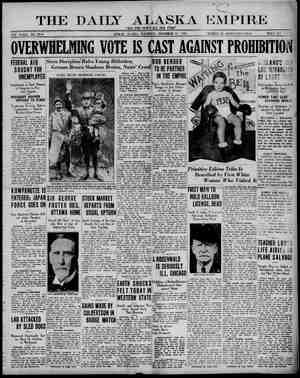Evening Star Newspaper, December 31, 1931, Page 12
You have reached the hourly page view limit. Unlock higher limit to our entire archive!
Subscribers enjoy higher page view limit, downloads, and exclusive features.
WASHINGTON, D. C., THURBSDAY, DECEMBER 31, 1931 ——— e &uz,fl;_fl'fih EVENDIG DRAR something to crystal-gazing Comes now the Scientist to assure us that crystal-gazing is something more than just “hocus-pocus” to fool the credulous. Freed of its ponderous verbiage, the Scientist’s explanation of crystal- gazing phenomena is something like this: What we actually see in the depths of the crystal are images derived from our own subconscious minds . . . things we would be and do if freed from the inhibitions of our daily surroundings. In words of one syllable, crystal-gazing is nothing more or less than taking stock of our own shortcomings and our own possibilities. Well . . . isn’t that about the only way in which the future can be predicted? So, as we concentrate upon the potentialities, possibilities and probabilities of 1932, let’s concern ourselves, not with what the N~w Year is going to bring us, but with what we are going to bring to the New Year. ' Are we going into Nineteen-thirty-two with the “business-s-rotten” complex that dominated so many in Nineteen-thirty-one . . . or are we going to adopt the “business-can-be-made-good” attitude of the few - who forced the passing year to yield them their normal sales increases? Are we going to continue to be dominated by the laziness acquired in times that were too good to last, or are we going to admit that good times are made only by hard work done when times are not so good? Are we going to sit around, berating the public for putting its money into savings banks and refusing to buy, or are we going to put more effort into presenting merchandise which the public wants rather than that which we would like to have the public buy? Are we going to cling to the absurd idea that there is no use in advertising because the public is not in a buying mood, or are we going to put the public into a buying mood by intelligent advertising of intelligently planned .offerings of things for which the public is anxious to spend its money? Remember . . . the man who waits for “business to turn,” before he starts to advertise, is too late. He finds his potential customers going to the store that kept itself in the public consciousness uninterrupt- edly . . . the store that told its story to the public before the public was ready to buy. If you have a competitor who is finishing the yeat in a stronger position than the one in which you find yourself, it is because he did his crystal-gazing twelve months ago, and is entering Nineteen-thirty-two with the momentum acquired by the extra effort put into Nineteen-thirty-one, and with the extra strength and skill developed in wresting good business from adversity. He has been merchandising and advertising as he would if times were good, and as a result he finds that times actually are good . . . for him. It is a matter of satisfaction to us to know that those stores that did make big successes in 1931 were extensive and consistent users of The Star, because those who knew that business could be made good included in their program the use of the most effective means of reaching Greater Washington. Reaching more than 100,000 homes in the area least affected by fluctuating business conditions, The Star tells the sales story where the most inmediate response can be stimu- lated . . . tells it with authority and compels belief. It is a matter of no less satisfaction to know that The Star is a dom- inant factor in the programs of those who have already done their crystal-gazing and made their plans for realizing in Nineteen-thirty- two on the little extra effort and the extra intelligence that made the he Star THE * NEWSPAPER ALL WASHINGTON READS old year successful.



